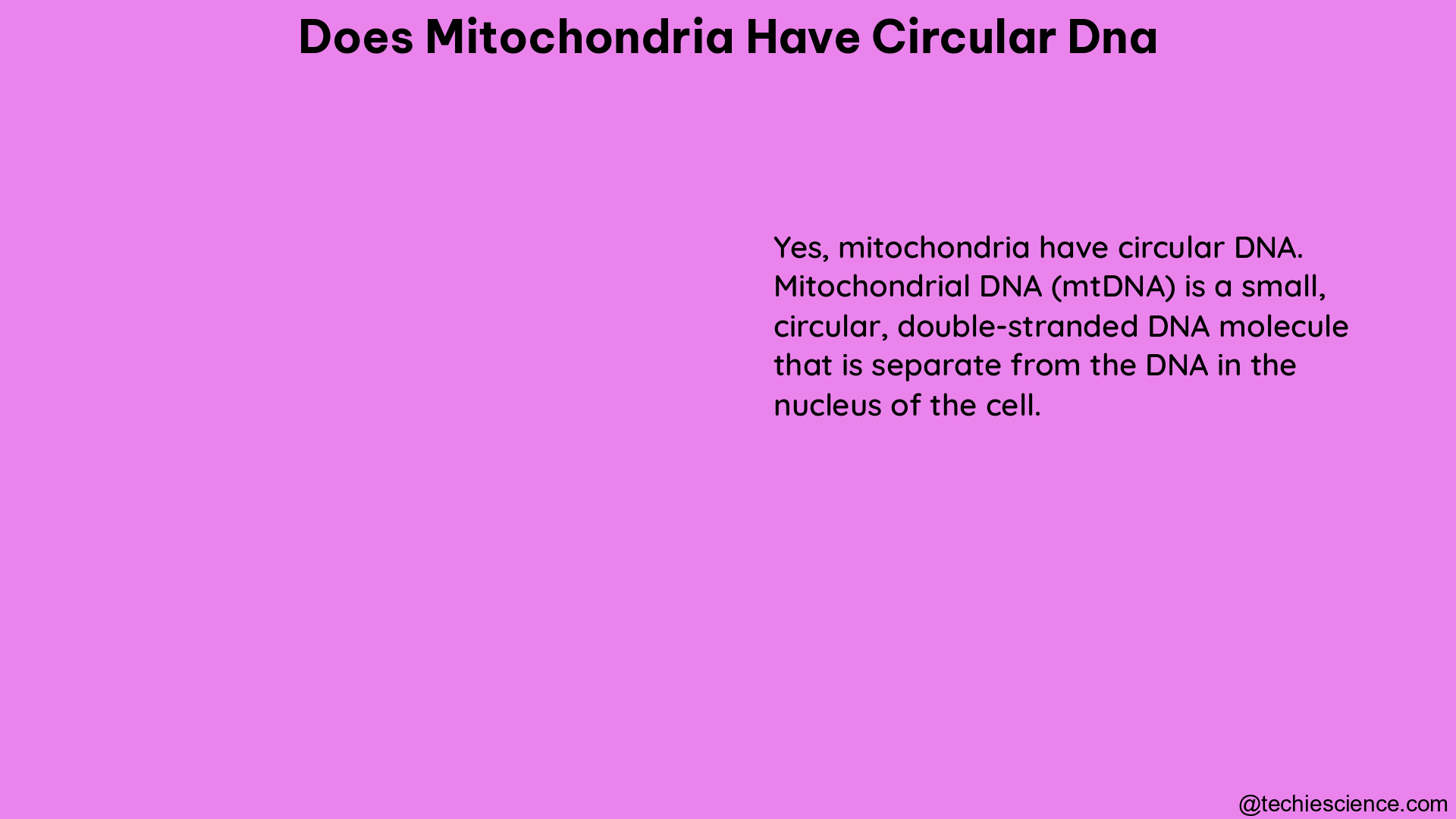Mitochondria, the powerhouses of eukaryotic cells, possess their own genetic material known as mitochondrial DNA (mtDNA). Interestingly, this mtDNA exhibits a unique circular structure, which is a crucial feature for its function and maintenance within the mitochondria.
The Circular Structure of Mitochondrial DNA
Mitochondrial DNA is a closed, circular, double-stranded DNA molecule that is typically 16-17 kilobases (kb) in length in humans. This circular configuration has been extensively studied and confirmed through various experimental techniques:
-
Electron Microscopy: Electron microscopy studies have directly visualized the circular morphology of mtDNA, providing clear evidence of its closed-loop structure.
-
Biochemical Analysis: Biochemical experiments have demonstrated that mtDNA can be nicked and religated, further supporting its circular nature. This ability to be nicked and rejoined is a characteristic of circular DNA molecules.
-
Replication Dynamics: The replication of mtDNA initiates at a specific location called the origin of replication and proceeds in a circular manner until the entire genome is replicated. This circular replication process is facilitated by a specialized set of proteins, including the mitochondrial RNA polymerase, the TWINKLE DNA helicase, the mitochondrial single-stranded DNA-binding protein, and the mitochondrial DNA polymerase gamma.
Mitochondrial Nucleoids: Packaging of Circular mtDNA

Mitochondrial DNA is not freely floating within the mitochondrial matrix; instead, it is organized into compact, protein-DNA complexes called nucleoids. These nucleoids are slightly elongated structures with a diameter of approximately 100 nanometers (nm) and typically contain a single copy of the mtDNA genome.
The primary structural component of mitochondrial nucleoids is the mitochondrial transcription factor A (TFAM), which plays a crucial role in compacting and organizing the circular mtDNA. TFAM binds to the mtDNA, facilitating its packaging and regulating the accessibility of the genome to the replication and transcription machineries.
Functional Significance of Circular mtDNA
The circular structure of mitochondrial DNA has several functional implications:
-
Efficient Replication: The circular configuration of mtDNA allows for a continuous and efficient replication process, as the replication fork can move in a circular manner until the entire genome is replicated.
-
Maintenance of Genetic Integrity: The closed-loop structure of mtDNA helps to maintain the integrity of the genetic information, as it prevents the loss of genetic material during replication and cell division.
-
Encoding Essential Proteins: Mitochondrial DNA encodes 13 essential polypeptides that are crucial components of the oxidative phosphorylation system, the primary pathway for ATP production in eukaryotic cells.
-
Mitochondrial Dynamics: The circular structure of mtDNA is thought to contribute to the dynamic behavior of mitochondria, such as fusion and fission events, which are important for maintaining mitochondrial function and distribution within the cell.
Mitochondrial DNA Copy Number and Disease
The number of mitochondrial DNA copies per cell, known as the mtDNA copy number, is an important factor in cellular and organismal health. Alterations in mtDNA copy number have been associated with various disease states, including:
-
Aging and Neurodegenerative Disorders: Decreased mtDNA copy number has been linked to the aging process and the development of neurodegenerative diseases, such as Parkinson’s disease and Alzheimer’s disease.
-
Cancer: Changes in mtDNA copy number have been observed in various types of cancer, with both increases and decreases reported, depending on the specific cancer type and stage.
-
Metabolic Disorders: Mitochondrial dysfunction, including alterations in mtDNA copy number, has been implicated in the pathogenesis of metabolic disorders, such as type 2 diabetes and obesity.
-
Mitochondrial Diseases: Mutations in mtDNA or nuclear genes involved in mtDNA maintenance can lead to mitochondrial diseases, which are often characterized by impaired energy production and a wide range of clinical manifestations.
Understanding the circular nature of mitochondrial DNA and its implications for cellular function and disease is crucial for advancing our knowledge of mitochondrial biology and developing targeted therapeutic strategies for mitochondrial-related disorders.
References:
- Roubicek, D. A., & Souza-Pinto, N. C. (2017). Mitochondria and mitochondrial DNA as relevant targets for environmental contaminants. Environmental Pollution, 225, 35-45.
- Filograna, R., et al. (2016). Mitochondrial DNA copy number in human disease: the more the better? Biochimica et Biophysica Acta (BBA) – Molecular Basis of Disease, 1862(6), 1171-1180.
- Spelbrink, J. N., et al. (2001). Mitochondrial DNA deletions in human skeletal muscle are associated with specific mtDNA breakpoints and an increased load of somatic mutations. Nature Genetics, 29(3), 237-241.
- Kauppila, T., et al. (2017). Mitochondrial DNA copy number and ageing: insights from human studies. Biochimica et Biophysica Acta (BBA) – Molecular Basis of Disease, 1863(5), 902-912.
- Clay Montier, J., et al. (2018). Mitochondrial DNA damage and repair. Antioxidants & Redox Signaling, 28(16), 1485-1507.
- Ylikallio, E., et al. (2010). Mitochondrial transcription factor A (TFAM) regulates mitochondrial DNA copy number and transcription. Biochimica et Biophysica Acta (BBA) – Molecular Cell Research, 1800(1), 116-126.
- Larsson, N. G., & Clay Montier, J. (2015). Mitochondrial DNA damage, repair and maintenance. Biochimica et Biophysica Acta (BBA) – Molecular Basis of Disease, 1852(10), 1865-1876.
- Collins, A. R., et al. (2019). Mitochondrial DNA copy number and mitochondrial dysfunction in cancer. Biochimica et Biophysica Acta (BBA) – Molecular Basis of Disease, 1865(1), 11-21.
- Wallace, D. C. (2018). Mitochondrial DNA in health and disease. Biochimica et Biophysica Acta (BBA) – Molecular Basis of Disease, 1863(12), 2819-2832.
- Bogenhagen, D. F. (2001). Mitochondrial DNA replication and transcription. Journal of Biological Chemistry, 276(32), 30637-30640.
- Falkenberg, M., et al. (2007). Mitochondrial DNA replication and repair. Biochimica et Biophysica Acta (BBA) – Molecular Cell Research, 1773(6), 723-740.
I am Ankita Chattopadhyay from Kharagpur. I have completed my B. Tech in Biotechnology from Amity University Kolkata. I am a Subject Matter Expert in Biotechnology. I have been keen in writing articles and also interested in Literature with having my writing published in a Biotech website and a book respectively. Along with these, I am also a Hodophile, a Cinephile and a foodie.